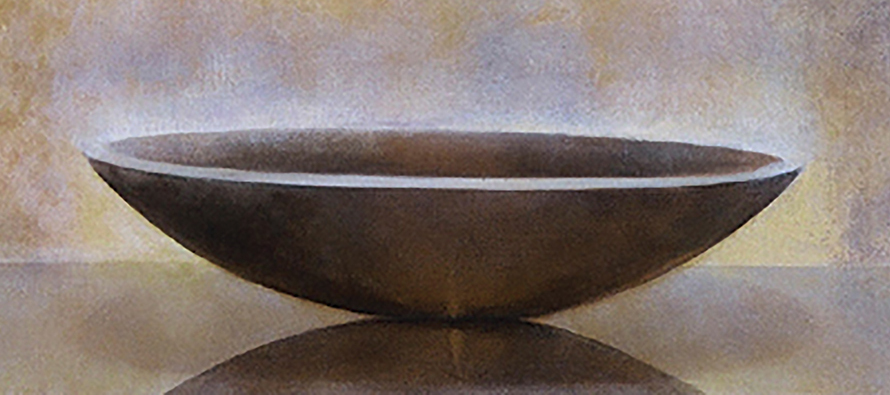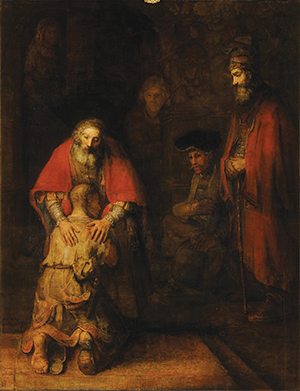Art: A way into prayer

“This bowl may be the empty bowl of my life, which I offer Him,” writes Sister Penelope Martin, O.C.D., “earnestly desiring that He fill it with whatever way of life most pleases Him.”
ART HAS ALWAYS PLAYED a major role in my prayer as a member of my religious order of Our Lady of Mount Carmel. Carmelites have as their reason for being the work of prayer: praying for the church and for the needs of the whole world. To this end we are an “enclosed” community—that is, we do not leave the monastery except for essential business. Far from being a restriction for its own sake, it is designed to free us and all our energies for our great task of prayer.
In everyday terms it means we follow a strict timetable, known as the horarium (from the Latin hora—an “hour”), which revolves around the singing of the Divine Office of the church and one hour of private, silent prayer every morning and evening. Each person has her own way of being during this silent prayer hour, and it is probably true to say that there are as many ways of praying as there are people committed to prayer. Fortunately for me I discovered meditation using pictures.
You don’t have to be an expertThis monastery has always encouraged looking at art in the form of reproductions either for its own sake or as an aid to prayer. We are fortunate in having a large library of well-illustrated art books, and sisters regularly give talks about or write commentaries on pictures that appeal to them.
| Rembrandt’s The Return of the Prodigal Son (1669) |
At first I was somewhat overawed by these offerings. Surely I would need a degree in the history of art to arrive at such insights? At the very least I would have to have studied art—and I had not. Then came a “eureka” moment. Somebody with an extensive and profound knowledge of art said this: Everyone’s response to a work of art is valid. The important thing is to really take time to look at a painting. A true work of art will always elicit its own response. In other words: Anyone can do it—even an “ignoramus” like me. How to begin?
Get to know itIt has been suggested that the best way to write a book is simply to sit down and begin. Similarly the best way into using art as a pathway to prayer is simply to try it out. The first thing is to find a picture—be it of a drawing, painting, or sculpture—that you like, and then to spend time with it. Using the internet can be helpful: There are thousands of photographs of paintings and sculptures online as well as a wealth of information about each work and every artist, and that is certainly valuable as background information. But to pray with an image you need to have it, if not actually in front of you, then at least securely in your mind’s eye. So I think an actual reproduction is essential. I keep it propped up in a place where I can see it often so that I can think about it often. Gradually it, too, speaks to me.
To put it another way: We become well-acquainted. The image becomes a visual memory, one that I can recall either during my prayer hour or at any time as I go about my day. I think about it perhaps in its historical setting but mostly with reference to God and the life I try to live in Christ. Thus I find myself praying with this image; maybe using words, maybe just letting it be in my mind’s eye, offering it to God and asking God to work in and through it. It cannot be stressed too strongly that prayer is actually God’s work, not mine or yours, and that focusing on a work of art is merely one way of trying to keep my mind on the things of God rather than on myriad distractions. “Let your minds be fixed on heavenly things, not on things here on earth,” writes Saint Paul in his Letter to the Colossians (3:2). Art at its best is a pointer, or doorway, to heavenly things.
Some examplesOver the years I have used a wide variety of pictures in my prayer, from Old Masters having a specifically religious subject—for example Rembrandt’s The Return of the Prodigal Son—to abstract works by contemporary artists. Sometimes I find that nonrepresentational, modern art gives me a greater freedom of interpretation—or is simply more restful. Simple lines and vivid colors allow me to imagine entering into that space as surely as in my prayer I enter into the very Being of God and am held there.
| Child with a Dove by Pablo Picasso (1901) |
Alternatively I might choose a more complex image. One of my favorite paintings is Child with a Dove, one of Pablo Picasso’s earlier works and a portrait surely of the innocence and vulnerability of children. The dove, which the child is clasping so firmly yet so gently, I see as the Spirit of Life within each of us. Child and dove are so helpless, so easily crushed; life can be brutal, as we know. Yet Jesus tells us, “Every hair on your head has been counted” (Matthew 10:30).
What a challenge this protestation of extravagant love is to us—and how we need to hold fast to it! As that great Carmelite saint, Thérèse of Lisieux, knew only too well: Growth in the Spirit relies on “trusting to the last in His fatherly goodness.” So hard, and yet that is all there is to it.
An image I have turned to again and again over the years is Remember This, a strikingly beautiful yet very simple picture of an empty bowl by the contemporary American artist Loretta Roome. The title of this painting seems to suggest a past association, but for me this picture is all about the future, about potential. I may see it as the bowl of my “daily bread”: an empty bowl, which I hold up in trust, each day, to my heavenly Father, knowing that he will fill it with nourishing bread. “What father among you would give his son a stone, if he asked for bread?” (Luke 11:11). What a challenge to faith when what I get seems to be very far from good, satisfying bread.
“Something happens”There are many ways in which an artist may let us see a picture. Whether we know the artist’s personal point of view does not necessarily matter. It may be of interest—but it may also inhibit my own response. A true work of art surely has a life of its own, and when I really engage with it, with all humility, openness, and a readiness for God, then something happens and I am truly enriched.
Tags
Related
- Beware of bots and bad actors as you engage online
- Call stories to help you discern
- Five reasons to pray the Liturgy of the Hours
- Tune into your prayer life
- Embody your decisions
- Your mission awaits you! Pope Francis' message to young people
- My portable prayer life
- Unravel the mystery of your call
- Religious life today (infographic)
- Religious vocation or family? Read More
Most Viewed
- Find your spirituality type quiz
- Questions and answers about religious vocations
- Celibacy quiz: Could I be a nun? Could I be a brother? Could I be a priest?
- Resources for older discerners or those with physical and developmental differences
- About Vocation Network and VISION Guide




 Sister Penelope Martin, O.C.D. is a Carmelite nun and a member of the community at the Carmelite Monastery, Quidenham, Norfolk, England,
Sister Penelope Martin, O.C.D. is a Carmelite nun and a member of the community at the Carmelite Monastery, Quidenham, Norfolk, England,